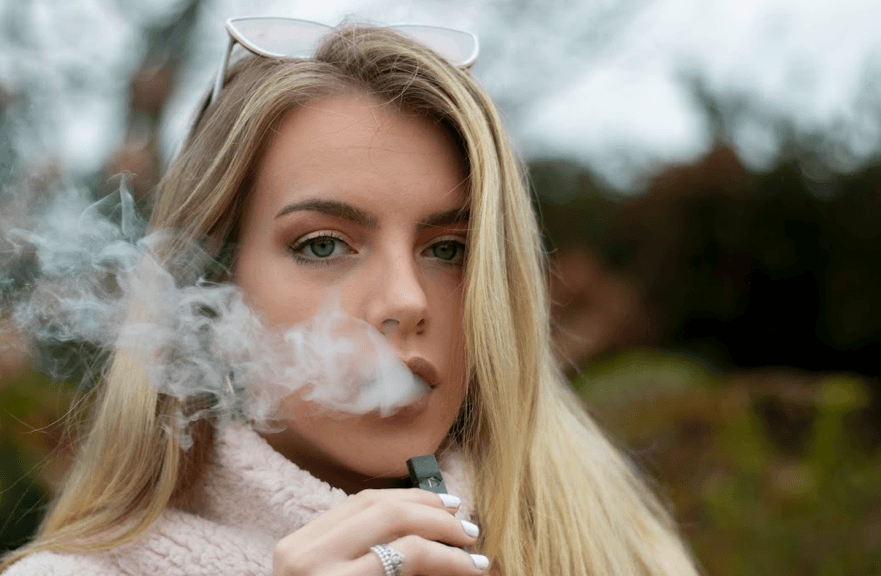by Theresa Brown and Julia Moro
Despite the health concerns about vaping, senior Brianna Dupont still enjoys using her Juul. Photo by Grace DeSanti.
On Oct. 4, Rhode Island Governor Gina Raimondo issued an executive order banning the distribution and retail of flavored e-cigarettes and vapes for four months, creating controversy throughout the state and at the University of Rhode Island.
According to the Providence Journal, Raimondo issued the order in response to what she described as a “public health crisis” among the state’s youth. She argued that the flavors of these vapor products are marketed to children and young adults, therefore creating more of a chance that they will pick up vaping and acquire a nicotine addiction.
The ban forced over 400 licensed vaping retailers to remove related products from their shelves, according to WPRI. This has affected stores around URI, such as Kingston Mart.
Sunshine Vape, located in South County Commons, has also experienced a decline in business, and was forced to remove the majority of the products from their shelves.
“You can look at the many empty shelves to start, the juice is the biggest thing when it comes to this business,” said Oliver Walsh, an employee at Sunshine Vape. “Really what we’re making our money off of is the liquid. So, a lot of our sales have gone away. A lot of people either just don’t want to vape something that tastes like a cigarette or they’re going back to smoking cigarettes.”
Walsh said vaping didn’t become recreational until Juul began selling products that were easier for younger generations to use. Walsh said this is why he thinks that Juul ruined the vaping industry.
“It gave you something that was cool,” said Walsh. “It was small [and] discreet, but they have nicotine levels that were way too high.”
Walsh noticed the demographic coming to the store also got a lot younger.
“Again, I’m blaming Juul for that,” said Walsh. “We got a lot more kids from URI coming over here.”
According to the Center for Disease Control and Prevention, there have been 1,888 lung injury cases as of Oct. 29 and 37 deaths in 24 states. Seventy-nine percent of patients are under 35 years old and 40 percent are 18 to 24.
Seventy-eight percent were affected by THC containing products with or without nicotine and 58 percent reported using nicotine containing products with or without THC. Only 10 percent just used nicotine containing products.
Dr. Christopher Nasin, the medical director at Health Services, and Ellen Reynolds, the director of Health Services, both said they believe flavored vapes were targeted for younger adults and kids.
“I don’t think that cotton candy [flavored vapes] were marketed for a 50-year-old man,” said Reynolds. “It was intentionally targeted for, I want to hope at least young adults.”
Reynolds also said that she doesn’t know if she can confidently say vaping is better than smoking cigarettes.
“We’re figuring it out right away that there’s a certain population that’s getting critically ill with it,” said Reynolds. “The good news is we’re not waiting 50 years to figure this out.”
Nasin said that he doesn’t think that the vaping companies intended to harm anyone with their products, but wanted to get people addicted.
“The nicotine content in the vapes are much higher than that of a cigarette,” said Nasin. “It was marketed as a safe alternative to smoking, but that’s not true. It’s actually even more addicting.”
According to Nasin, the most common effect of vaping is pneumonitis, which is inflammation of the lung. He also said that figuring out the dangers of vaping is complicated because it’s all based on the individual.
“You could have 10 people, five may have a significant reaction and the others may not,” said Nasin. “That further complicates it and makes it more difficult for us to figure out who is susceptible.”
Reynolds agreed and said that it’s hard to know who will be harmed.
“You also don’t know if you’re going to be someone who develop prolific lung injury that could have lifelong impact if you are lucky enough to live,” said Reynolds.
According to Reynolds, Health Services has seen the effects these products have taken on students.
“We have certainly seen a slight uptick in the number of students who are looking to quit,” said Reynolds. “We’ve developed group programs and we’re ready to meet with them as needed and when they’re ready.”
However, junior chemistry and Chinese student Jack Ryan Mazzarelli said he has not seen this from his peers. Instead, Mazzarelli said his peers are simply inconvenienced.
“I’ve heard people complain about the inconvenience it is getting [vape juice],” Mazzarelli said. “They don’t see it as ‘I need to stop vaping,’ they see it as ‘Now it’s hard for me to get vape products.’ There’s a girl in my chemistry class that drove all the way to Connecticut to get Juul pods.”
Junior computer science major Nick Tansino said if the ban is never lifted, the University will see changes in the way students are dealing with their new, vape-influenced addictions to nicotine.
“I think you’re going to have a lot more tobacco on campus,” Tansino said. “One thing that it definitely affects is the population of people who quit smoking [cigarettes] and vape to find another way than quit cold turkey. All those people are going to have nothing else to go back to.”
Health Services has nicotine replacement products free of cost to students who are looking to quit. Students interested in seeking help from Health Services should visit their website at health.uri.edu.





